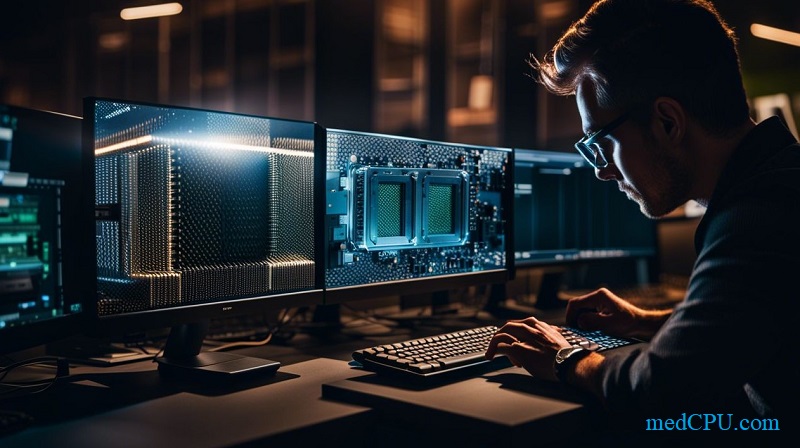Are you an avid gamer looking to upgrade your gaming laptop or purchase a new one? Knowing how to check gaming laptop specs is crucial to ensure that you get the best gaming performance possible. In this article, medCPU walks you through the step-by-step process of checking the essential specifications that determine a gaming laptop’s power and capabilities. From processors and graphics cards to storage and display options, we’ll cover it all. So, let’s dive in and make sure you’re well-equipped to make an informed decision for your next gaming machine.
Why Checking Gaming Laptop Specs is Important
Checking gaming laptop specs is important because it ensures compatibility with game requirements and helps determine if the laptop meets desired performance standards.
Ensures compatibility with game requirements
As avid gamers, we know the pain of encountering lag or worse – a game not running at all due to incompatible hardware. This is why checking gaming laptop specs is crucial. It’s all about ensuring your device meets the necessary system requirements specified by the game developers.
From CPU and GPU capabilities to RAM size and storage space, these specifications determine how well a particular game will run on our laptops. When our laptop’s hardware aligns with the demands of our favorite games, we can dive into an immersive experience without glitches or interruptions ruining our fun.
Read more: GPU vs CPU: Which Is Better And Why?
Determines if the laptop meets desired performance standards
In the world of gaming, performance is king. Checking the specs of a gaming laptop allows us to determine if it can meet the desired performance standards for our favorite games. It’s all about ensuring smooth gameplay, excellent graphics quality, and quick load times.
We consider several factors when evaluating performance standards such as the CPU speed, GPU power, RAM size, and storage type—each contributing on different levels towards actual in-game experience.
For instance, a powerful processor (CPU) ensures faster data processing while ample memory (RAM) contributes to smoother multi-tasking capabilities during gameplay.
Running benchmark tests is another way we verify if a laptop is up to par with specific game requirements – this involves putting your system through various synthetic and real-world scenarios to evaluate its performance comprehensively.
By checking these specs beforehand using tools like DirectX Diagnostic or Windows System settings menu, we ensure not only compatibility but also that we’ll get the most enjoyment out of our gaming sessions without experiencing lag or other annoying disruptions.

How to Check CPU (Processor) Specs
Let’s dive into the process of checking CPU specifications in a gaming laptop. This can easily be done using built-in system tools on your computer, such as the Windows System Information or DirectX Diagnostic Tool.
First, you need to open the System Information window by pressing ‘Windows + R’, typing ‘msinfo32’ into the run box that appears, and hit Enter. Your CPU specs will be listed under ‘Processor’ in the System Summary.
If you want more detailed information like clock speed and cores, utilizing the DirectX Diagnostic tool might be beneficial. Access this tool by typing ‘dxdiag’ into your search bar and selecting it from the results list; under the “System” tab, look for ‘Processor’.
These steps guide us as we check our gaming laptop’s CPU specs for a better understanding of its performance capabilities and potential enhancements required.
How to Check GPU (Graphics Card) Specs
To check the GPU (Graphics Card) specs of a gaming laptop, start by opening the Windows settings menu. From there, navigate to the System tab and click on Display in the left sidebar.
Scroll down and look for the section labeled “Display adapter properties.” Clicking on this will bring up a window with detailed information about your graphics card.
Another way to check GPU specs is by using third-party software such as CPU-Z or GPU-Z. These programs provide comprehensive information about your GPU, including its model, manufacturer, clock speed, memory size, and more.
It’s important to note that not all laptops have dedicated GPUs; some may rely on integrated graphics instead. To determine if your laptop has a dedicated graphics card or integrated graphics, you can also right-click on your desktop and select “Display settings.” Under the Display tab, click on “Advanced display settings” and then choose “Display adapter properties.” This will show whether you have an integrated or dedicated GPU.
By checking the GPU specs of a gaming laptop, you can ensure that it meets the requirements for running specific games smoothly. Understanding your graphics card’s capabilities is crucial for an optimal gaming experience.
How to Check RAM (Memory) Specs
To check the RAM (memory) specs of a gaming laptop, you can follow these simple steps. First, open the Windows settings menu by clicking on the Start button and selecting “Settings.” Then, click on the “System” option and choose “About” from the left-hand side menu.
Here, you will find information about your laptop’s processor, installed RAM, and system type.
Another way to check RAM specs is by using the DirectX Diagnostic tool. Simply press the Windows key + R to open the Run dialog box, then type in “dxdiag” and hit enter. In this diagnostic tool window, go to the System tab where you can see the total amount of memory (RAM) installed on your gaming laptop.
Remember that when checking RAM specs for gaming laptops, it is important to consider both capacity (measured in gigabytes or GB) and speed (measured in megahertz or MHz). Generally, higher amounts of RAM will allow for smoother gameplay and better multitasking capabilities.
So be sure to compare these specifications with recommended requirements for games you plan to play on your laptop.
How to Check Storage (Hard Drive/SSD) Specs
To check the storage specs of a gaming laptop, you can use the Windows System Information or physically inspect the hard drive or SSD.
Using Windows System Information
To check the specifications of your gaming laptop using Windows System Information, simply follow these steps. First, click on the Start menu and search for “System Information”. Once you open the application, you will see a detailed overview of your system’s hardware and software components.
This includes information about your CPU, GPU, RAM, storage capacity, and more. You can easily navigate through the different categories to find specific details about each component.
The Windows System Information tool provides a convenient way to quickly access all the necessary information about your gaming laptop specs in one place without any hassle or confusion.
Checking physical storage components
To check the physical storage components of a gaming laptop, you can start by accessing the Windows System Information. This can be done by pressing the Windows key + R to open the Run dialog box, then typing “msinfo32” and hitting enter.
In the System Information window that appears, navigate to Components > Storage > Disks. Here, you will find detailed information about your hard drive or solid-state drive (SSD). You can also physically check your laptop for any additional storage options such as an extra SSD slot or an M.2 slot for expansion.
By understanding your storage specs, you can ensure that your gaming laptop has enough space to store games and other files without experiencing performance issues related to limited storage capacity.
Additional Specifications to Check for Gaming Laptops
- Check the display resolution and refresh rate, as a higher resolution and faster refresh rate provide a more immersive gaming experience.
- Consider the connectivity ports available on the laptop, such as HDMI and USB, to ensure compatibility with gaming accessories and external devices.
- Evaluate the battery life of the laptop, especially if you plan on gaming on the go, and make sure that it has an adequate power supply for optimal performance.
Display resolution and refresh rate
When it comes to gaming laptops, display resolution, and refresh rate are key factors that can greatly enhance your gaming experience. The display resolution refers to the number of pixels on the screen, which affects the sharpness and clarity of the images.
A higher resolution means more detailed graphics, allowing you to fully appreciate the stunning visuals of modern games.
On the other hand, the refresh rate determines how many times per second the image on the screen is refreshed. A higher refresh rate results in smoother motion on-screen, reducing blur and ghosting during fast-paced gameplay.
This makes a significant difference in competitive gaming where every millisecond counts.
To check these specifications, simply go into your laptop’s settings or search for “display” in your Windows Start menu. Here you will find information about your current display resolution and refresh rate.

Connectivity ports (HDMI, USB, etc.)
Connectivity ports are an essential aspect to consider when checking gaming laptop specifications. These ports allow you to connect external devices such as monitors, keyboards, mice, and other peripherals.
The most common connectivity ports found on gaming laptops include HDMI (High-Definition Multimedia Interface) and USB (Universal Serial Bus). HDMI ports are used for connecting your laptop to a larger display or monitor for an enhanced gaming experience with better visuals.
USB ports, on the other hand, provide options for connecting various accessories such as external hard drives, game controllers, or even charging your smartphone while you play. It’s important to check the number and type of connectivity ports available on a gaming laptop to ensure compatibility with your desired peripherals and accessories.
Battery life and power supply
One important aspect to consider when checking gaming laptop specs is the battery life and power supply. A longer battery life allows for uninterrupted gaming sessions, especially if you’re often on the go or don’t have access to a power outlet.
Additionally, it’s crucial to ensure that your laptop has a reliable power supply that can handle the demands of gaming without overheating or causing performance issues. By checking the battery life and power supply specifications of a gaming laptop, you can make an informed decision and find a device that meets your needs for portable gaming.
Using the website to check a gaming computer’s configuration
In addition to the methods mentioned above, you can use one of the two websites listed below to check the configuration of your gaming laptop.
1. Website SystemRequirementsLab.com
Step 1: Visit the homepage https://www.systemrequirementslab.com/
Step 2: Enter the name of the Game that you need to check in the Search game box -> then, select that game in the list of suggestions as shown below.
Step 3: Next, click the Can you run it button.
Step 4: On the next page, the required configuration of the game will appear for you to compare with the corresponding configuration of the machine that can meet.
But your goal is to use the automatic comparison utility that the website offers, so we will skip this part by clicking Can you run it again?
Step 5: At this point, please note that after catching the download link (a download dialog box appears) asking to download a file called Detection.exe (about 4MB), please quickly click the stop page download button on the toolbar of the web browser as shown below!
Note: This is probably an error of this Website because the purpose is to stop here to wait for the user to install the Dectection.exe file, the page will continue to download a Bank Page if you don’t quickly click stop.
Step 6: In the next step, you proceed to run the .exe file that you have just downloaded and wait for the software to collect information about the computer such as CPU, OS, RAM, Graphics Card, and DirectX … this process happens completely automatically.
Step 7: The installation is complete, go back to the browser and now the tool has given the final result.
Step 8: Looking at the picture, you can also see that the computer can meet the Minimum (minimum configuration) of the GTA 5 game, that is, it can smoothly respond to the game when adjusted to Low graphics level.
2. Website game-debate.com
Step 1: You access the support website https://www.game-debate.com/
Step 2: Click on the magnifying glass icon on the right corner of the website, after clicking, a search box will appear, and start typing the name of the game or software application to check (Here we will check whether the computer configuration can play PUBG game or not!)
Step 3: Click on the result that the Game-debate page has returned for you. Here, this page will give you 2 configurations, the minimum configuration, and the recommended configuration, the bottom part is the display information about the game (this page measures the big FPS when playing PUBG in the built-in configuration is 139 FPS) if you are interested, you can refer to it or we can start scrolling down to go to the configuration check!
Step 4: Here this page has 5 options, you choose the hardware components corresponding to your computer configuration.
- Laptop: In this option, it means that when you use a laptop, click Yes, and if it is a desktop computer, select No.
- Modern Only: Means to display the latest hardware information, but we recommend leaving the default as No.
- Hardware Quality: Displays only hardware information that can play the Game with the minimum or recommended configuration, so the default is Any.
- Processor: CPU – is your central processor using Intel or AMD?
- Graphics: Is your computer’s video card NVIDIA or ATI – AMD? Choose the right one for your video card manufacturer.
Step 5: Choose the amount of RAM, here there is only 1 option, so we choose the total amount of RAM. After selecting, we click Check Specs to see the results.
Step 6: Done, if a message appears as shown, it means that your computer configuration is enough to play the Game.
Conclusion
In conclusion, checking gaming laptop specs is crucial for ensuring compatibility with game requirements and determining if the laptop meets desired performance standards. By examining CPU, GPU, RAM, and storage specifications, as well as considering additional factors like display resolution and connectivity ports, gamers can make informed decisions about their gaming laptops.
Taking the time to evaluate and understand these specifications will help optimize the gaming experience and ensure smooth gameplay. So don’t forget to check those specs before you embark on your next gaming adventure!
FAQs: How to Check Gaming Laptop Specs
1. What are the key specifications to check when evaluating a gaming laptop?
When checking gaming laptop specs, you should pay attention to the processor (CPU), graphics card (GPU), RAM, storage capacity and type (SSD or HDD), display resolution and refresh rate, as well as any additional features like keyboard lighting and cooling systems.
2. How can I find the specific details of a gaming laptop’s specifications?
You can find the specific details of a gaming laptop’s specifications by looking at its product page on the manufacturer’s website or checking the technical specifications in online reviews. You can also usually find this information on retailer websites or by contacting customer support for assistance.
3. What is the ideal minimum requirement for CPU and GPU in a gaming laptop?
An ideal minimum requirement for CPU would be an Intel Core i5 or AMD Ryzen 5 processor, while an NVIDIA GeForce GTX 1650 or AMD Radeon RX 5500M would be suitable for GPU. However, higher-end CPUs and GPUs will provide better performance for more demanding games.
4. Are there any important considerations besides raw specs when choosing a gaming laptop?
Besides raw specs, it is important to consider factors such as thermal management system efficiency, battery life, overall build quality including keyboard and trackpad comfort, portability if you plan to travel with it frequently, connectivity options like USB ports and HDMI outputs, as well as budget constraints.

Eyal Ephrat serves as the co-founder and CEO of medCPU.com, where technology is making significant strides in the field of medicine. Through his experience in purchasing PC and laptop equipment and various other tech products, Eyal Ephrat contributes valuable insights to medCPU’s mission.
